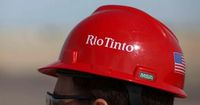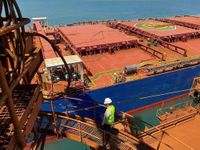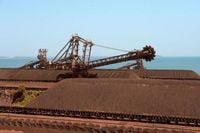Rio Tinto Group reported a significant decline in its first-quarter iron ore shipments, attributing the drop to severe weather disruptions caused by tropical cyclones in Australia’s Pilbara region. The mining giant announced that its shipments totaled 70.7 million tons, marking a 9% decrease from the same period last year and the lowest volume for a first quarter since 2019.
In a statement released on April 15, 2025, Rio Tinto's CEO Jakob Stausholm acknowledged the impact of extreme weather, stating, "We continued to see strong operational improvement with the Oyu Tolgoi copper mine and our bauxite operations delivering record months for production in March." However, he also highlighted the challenges posed by the cyclones, which resulted in an estimated loss of 13 million tons of production.
The company now anticipates that its Pilbara iron ore shipments for 2025 will fall within the lower end of its forecast range of 323 million to 338 million metric tons. This projection comes as Rio Tinto faces increasing competition from Brazil's Vale SA, which is also expected to meet its production targets.
Rio Tinto’s report noted that the first quarter saw a 17% drop in shipments compared to the previous quarter of 2024. The company is currently implementing recovery plans to mitigate losses, which include rectification works and additional contract mining services, at an estimated cost of about A$150 million (approximately $95 million).
Despite the challenges in the iron ore sector, Rio Tinto reported a robust performance in its copper division, with production rising 16% year-on-year to 210,000 tons. However, this figure reflects an 8% decline compared to the previous quarter due to unplanned conveyor failures at its Kennecott operation in Utah. The company has since restored the affected conveyor to full functionality.
In addition to copper, Rio Tinto celebrated a record first quarter for bauxite production, achieving 15 million tons, a 12% increase compared to the same quarter last year. The company’s aluminum output remained flat at 829,000 tons, while alumina production rose by 3% to 1.9 million tons.
Rio Tinto's iron ore production dipped 10% to 69.8 million tons, with both production and shipping affected by the cyclones. The company emphasized that its iron ore guidance remains contingent upon the timing of approvals for planned mining areas and heritage clearances.
As the company navigates these difficulties, its stock price reflected investor concerns, falling 1.2% to A$110.14, aligning with a broader 0.2% drop in the mining sector. Analysts are closely monitoring Rio Tinto’s ability to ramp up production while managing the challenges posed by weather-related disruptions.
Rio Tinto's 2025 outlook for iron ore shipments is particularly critical as it seeks to maintain its position as the world's largest iron ore producer. The company’s projections exclude an expected 9.7 million to 11.4 million tons from its Canadian operations, further complicating its overall production strategy.
Looking ahead, Rio Tinto is focusing on its long-term production goals, including plans for the Oyu Tolgoi underground mine, which aims for a more than 50% increase in copper output this year. The company is also progressing with its Simandou high-grade iron ore project in Guinea, which remains on track.
In addition to iron ore and copper, Rio Tinto has expanded its portfolio with the recent acquisition of Arcadium Lithium for $6.7 billion. This strategic move positions the company as a major player in the lithium market, aiming to grow its capacity to over 200,000 tons of lithium carbonate equivalent per annum by 2028.
Rio Tinto's commitment to investing in its operations and addressing production challenges is evident in its ongoing capital investment plan of $11 billion for 2025. The company remains focused on enhancing its operational efficiency and mitigating risks associated with weather disruptions.
As the mining industry continues to grapple with the effects of climate change, Rio Tinto's experiences serve as a reminder of the vulnerabilities faced by major producers. The company’s efforts to recover from recent setbacks will be closely watched by investors and industry analysts alike, particularly as it seeks to stabilize its iron ore output and compete effectively in a challenging market.
Overall, Rio Tinto's first-quarter results highlight both the challenges and opportunities within the mining sector, as the company adapts to changing conditions while striving to meet its production targets and maintain its competitive edge.









